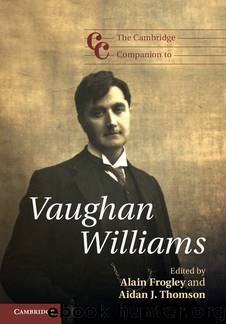The Cambridge Companion to Vaughan Williams (Cambridge Companions to Music) by The Cambridge Companion To Vaughan Williams (2013)

Author:The Cambridge Companion To Vaughan Williams (2013)
Language: eng
Format: epub
Publisher: Cambridge University Press
Published: 2013-11-14T02:00:00+00:00
Incidental music
A simple inventory reveals that most of Vaughan Williams’s dramatic works can be broadly classified as ‘incidental music’ (whether for stage plays, radio dramas, or film); however, in terms of their aggregate length, such works constitute less than half of his dramatic output. With a handful of exceptions, this music is not particularly well known. Much of it has never been recorded (or, as with much of the film music, has not been widely available until recently), and performances or broadcasts are rare. Nonetheless, these works are significant not just on their compositional merits, but for what they reveal about Vaughan Williams’s interest in artistic collaboration and his own personal creative growth.
His earliest (and one of his finest) efforts in this field came in the form of incidental music for Aristophanes’ The Wasps (1909), which he wrote for the Cambridge Greek Play Series. The Wasps is a bawdy political satire that criticizes the Athenian legal system via the protagonist, Philocleon (or Procleon), and his antagonistic son, Bdelycleon (or Anticleon). It was performed in Greek (although the vocal score published by the Cambridge Greek Play Committee featured English translations of the songs and choruses), required a relatively large, all-male cast,44 and featured a wide array of comic styles, from lowbrow puns to sophisticated social parody to a surrealistic dream sequence featuring enormous dancing crabs.45
Although the overture to The Wasps is one of Vaughan Williams’s most popular instrumental works, the score is rarely heard in its entirety. This is a great shame, for as he had recently completed his tutelage with Ravel, Vaughan Williams displays in the work a level of confidence that he had hitherto lacked. To describe it merely as ‘incidental music’ does not do it justice: while there are entr’actes and other passages for orchestra alone, there are also nine choruses (including a twenty-minute Parabasis) and several passages of melodrama in which the orchestra plays a critical role. It is also quite witty – much more so than Hugh the Drover or The Poisoned Kiss. For example, No. 17a in the full autograph score (the dream sequence with the Sons of Carcinus) features quotations from Mendelssohn (the famous Frühlingslied, Op. 62, No. 6), Offenbach (the ‘Apache Dance’ from the ballet Le Papillon and the opera Le Roi Carotte) and Lehár (a much-slowed and ominous-sounding version of the waltz from The Merry Widow), though none of these are present in the published vocal score. Instead, there is a note at the end of No. 17: ‘Here follows the entry music of the “sons of Carcinus” which will vary according to season’.46 This statement not only implies that Vaughan Williams fully expected The Wasps to be revived, but that future producers should not feel obligated to use the music he provided for this scene if they did not find it suitable or topical. This practice of suggesting possible performing modifications within the score became a hallmark of his later compositions, but the latitude he provided here is exceptional.
In 1911, Vaughan
Download
This site does not store any files on its server. We only index and link to content provided by other sites. Please contact the content providers to delete copyright contents if any and email us, we'll remove relevant links or contents immediately.
Aircraft Design of WWII: A Sketchbook by Lockheed Aircraft Corporation(32140)
The Great Music City by Andrea Baker(30797)
Call Me by Your Name by André Aciman(19931)
The Art of Boudoir Photography: How to Create Stunning Photographs of Women by Christa Meola(18414)
The Secret History by Donna Tartt(18224)
Shoot Sexy by Ryan Armbrust(17564)
Plagued by Fire by Paul Hendrickson(17119)
Portrait Mastery in Black & White: Learn the Signature Style of a Legendary Photographer by Tim Kelly(16877)
Adobe Camera Raw For Digital Photographers Only by Rob Sheppard(16805)
Photographically Speaking: A Deeper Look at Creating Stronger Images (Eva Spring's Library) by David duChemin(16504)
Ready Player One by Cline Ernest(14032)
Pimp by Iceberg Slim(13803)
Bombshells: Glamour Girls of a Lifetime by Sullivan Steve(13701)
The Goal (Off-Campus #4) by Elle Kennedy(13210)
Art Nude Photography Explained: How to Photograph and Understand Great Art Nude Images by Simon Walden(12858)
Kathy Andrews Collection by Kathy Andrews(11342)
The Priory of the Orange Tree by Samantha Shannon(8638)
Thirteen Reasons Why by Jay Asher(8472)
The remains of the day by Kazuo Ishiguro(8415)
